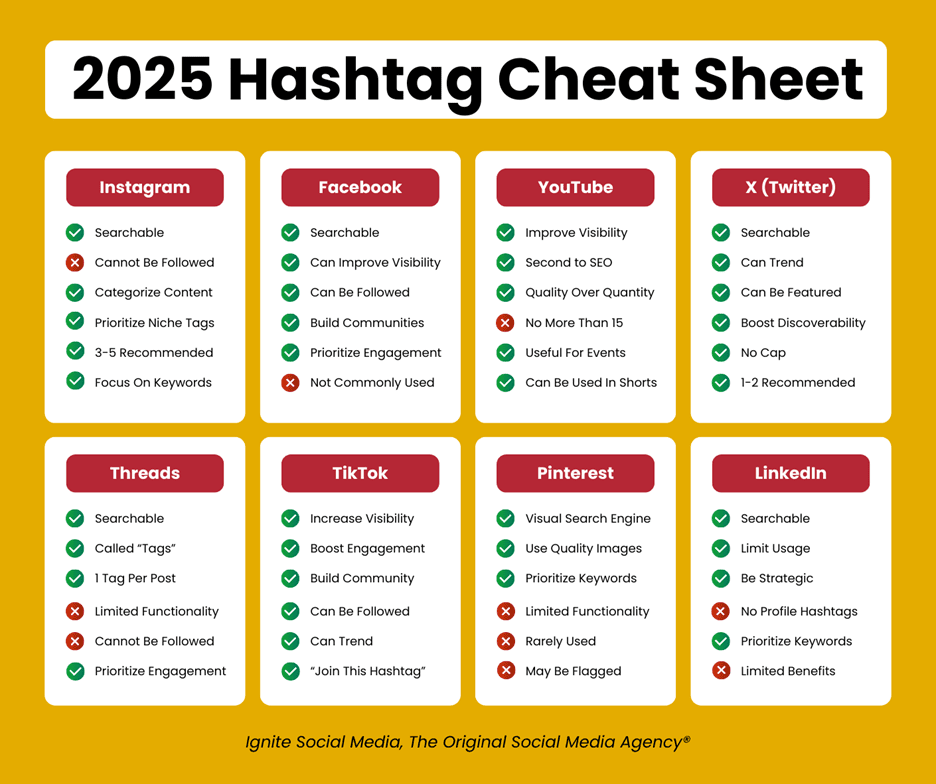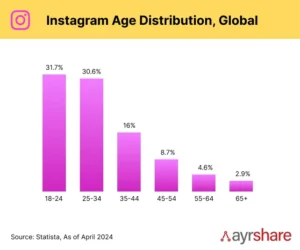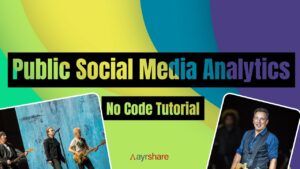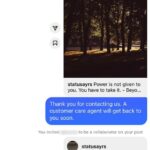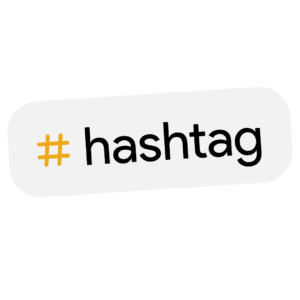 Hashtags have been a cornerstone of social media marketing for over a decade, but in 2025, their role is rapidly evolving. With major platforms like Instagram, LinkedIn, and X (formerly Twitter) shifting away from traditional hashtag strategies, many marketers are left wondering – are hashtags still worth using? The short answer: it depends.
Hashtags have been a cornerstone of social media marketing for over a decade, but in 2025, their role is rapidly evolving. With major platforms like Instagram, LinkedIn, and X (formerly Twitter) shifting away from traditional hashtag strategies, many marketers are left wondering – are hashtags still worth using? The short answer: it depends.
While hashtags are no longer the primary driver of reach and engagement on many platforms, they still serve a purpose in categorization, searchability, and branded campaigns. However, as social media algorithms prioritize AI-driven content recommendations and keyword-based discovery, marketers need to rethink their hashtag strategies to stay ahead.
In this guide, we’ll break down the current state of hashtags across major social platforms, best practices for 2025, and how brands can adapt their approach to maximize visibility. Whether you’re a seasoned social media manager or just starting out, understanding how hashtags fit into today’s digital landscape is key to creating an effective content strategy. Let’s dive in!
Hashtags have long been a valuable tool on Instagram, but in November 2024, the platform removed the option for users to follow hashtags and shifted its focus toward SEO-friendly captions for content discovery. However, that doesn’t mean hashtags are obsolete. They still play a role in boosting discoverability, building community, categorizing content, and branding.
Instagram allows up to 30 hashtags per post but recommends using 3-5 strategic, relevant hashtags instead of overloading your posts. The key is to be precise and use niche or industry-specific hashtags that directly relate to your audience.
For example, if you’re posting about a vacation to Oregon and Washington, a generic hashtag like #Travel is too broad and oversaturated. Instead, opt for regional and community-based hashtags like #pnwlove and #wanderwashington to connect with the right audience.
Sources:
🔗 Instagram Creators
🔗 Social Media Today
TikTok
Hashtags play a more significant role on TikTok, helping businesses and creators increase visibility, boost engagement, and build community. Unlike some other platforms, TikTok still encourages brands to use trending and relevant hashtags to connect with their audience.
Users can follow and favorite hashtags, making it easier to stay engaged with specific topics. TikTok also provides insights into related hashtags and their usage frequency, helping brands discover high-performing tags. Additionally, the “Join This Hashtag” feature allows users to participate in trending topics, making it a great way to jump into viral conversations.
Sources:
🔗 TikTok Business Creative Center
🔗 Sprout Social – TikTok Hashtags
X (f/k/a Twitter)
While hashtags are becoming less prominent on X, they still hold value for searchability and categorization. According to X, hashtags remain searchable, and popular hashtags can become trending topics featured in the Trends section of the Explore tab.
Tapping on a hashtag allows users to see other posts using the same tag, making them useful for content discovery. Additionally, incorporating relevant hashtags can help posts appear more easily in search results.
X allows users to include as many hashtags as they’d like, but the platform recommends using no more than two per post for optimal engagement.
Sources:
🔗 X Help Center – How to Use Hashtags
Hashtags no longer play a major role in LinkedIn’s algorithm, as the platform has shifted toward an SEO-driven approach for content discovery. Previously, users could add up to five hashtags on their profiles to improve visibility, but this feature has been phased out. While hashtags are still searchable and can be used in posts, LinkedIn now prioritizes natural language keywords and meaningful engagement over excessive tagging.
Rather than relying on hashtags, professionals and brands should focus on optimizing their profiles and content with relevant keywords to improve searchability. Engaging in thoughtful discussions, commenting on industry conversations, and creating high-value content are now the best ways to increase reach. While strategic hashtag use is still acceptable, it’s recommended to keep them minimal and highly relevant to the topic.
Sources:
🔗 Are LinkedIn Hashtags Dead? Here’s What the Algorithm Wants Now
🔗 Sprout Social: LinkedIn Hashtags Guide
 Facebook
Facebook
Hashtags are still supported on Facebook, but they do not significantly impact reach or engagement. The platform prioritizes keywords, meaningful interactions, and community engagement over hashtag use. While hashtags can help categorize content and make posts searchable, they are most effective in niche communities and for event marketing rather than general content discovery.
To maximize visibility on Facebook, focus on creating engaging content that encourages shares, comments, and discussions. When using hashtags, keep them purposeful and relevant, ensuring they add value to the conversation rather than relying on them for reach. Prioritizing audience interaction and well-optimized content will have a greater impact than excessive tagging.
Sources:
🔗 Facebook Help Center – Hashtags
🔗 Sprout Social – Hashtags on Facebook
Threads
Threads is rapidly growing, recently surpassing 300 million active users, making it an emerging platform for brands and marketers. However, hashtags function differently on Threads compared to other social platforms. Users cannot follow hashtags, and while they are searchable, their impact on content visibility is limited.
On Threads, hashtags are referred to as “tags”, and there is a functional limit of one per post. Unlike on other platforms, adding additional keywords with the hashtag symbol does not make them clickable or searchable. Instead of relying on hashtags, brands should focus on keyword-rich captions, engaging discussions, and content that encourages interaction to maximize visibility on the platform.
A recent study found that posts with the most comments were more likely to appear in users’ feeds, reinforcing the importance of sparking conversations.
Sources:
🔗 HeyOrca – Threads Social News
🔗 Buffer – Threads New Features
YouTube
Hashtags on YouTube help categorize content and improve discoverability, but they play a secondary role compared to strong SEO, compelling titles, and engaging thumbnails. Clicking a hashtag takes users to a dedicated results page featuring related content, but search terms and keywords have a greater impact on video rankings.
To effectively use hashtags, quality over quantity is key. Overuse (more than 60 hashtags) can result in YouTube ignoring them entirely or even removing the video from search. For best results, focus on niche and trending hashtags, location-based tags for travel content, and event-related hashtags to boost visibility. While hashtags can enhance searchability, engagement, watch time, and content quality remain the top factors for success on YouTube.
Sources:
🔗 YouTube Help – Hashtags
🔗 SendShort AI – Hashtags for YouTube Shorts
🔗 Sprout Social – YouTube Hashtags Guide
While Pinterest has social elements, it primarily functions as a visual search engine, making SEO a pivotal factor in content discovery. Users search for content using keywords, not hashtags, so well-optimized Pin descriptions with clear, relevant keywords are essential for visibility.
Hashtags have very limited functionality on Pinterest and are rarely used. In some cases, they can even appear spammy and reduce the effectiveness of a Pin. Instead, focus on high-quality images, keyword-rich descriptions, and engaging titles to improve discoverability. Since Pinterest is often used for product discovery, standout visuals and strategic SEO are the best ways to drive traffic and engagement.
Sources:
🔗 Sarah Burk – Pinterest Hashtags
🔗 Levee Road Studio – Hashtags on Pinterest
 Final Thoughts: Hashtag Strategy In 2025 And Beyond
Final Thoughts: Hashtag Strategy In 2025 And Beyond
While hashtags still provide value for categorization, searchability, and community engagement, they are no longer the primary driver of reach and visibility on most platforms. Their role is evolving as platforms shift toward SEO-driven content discovery and algorithm-based recommendations.
Brands must adapt their strategy to keep pace with a rapidly changing social landscape. Partnering with industry experts – like the team at Ignite Social Media, the first social-only marketing agency in the U.S. – can help businesses navigate these changes and develop a data-driven, results-oriented approach to social media marketing.
